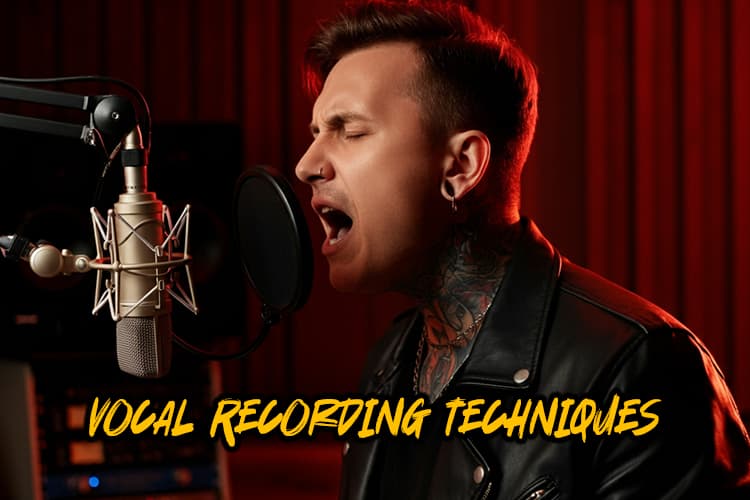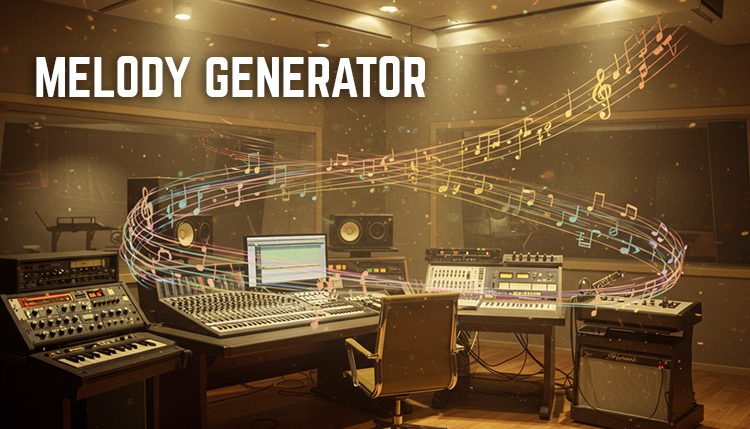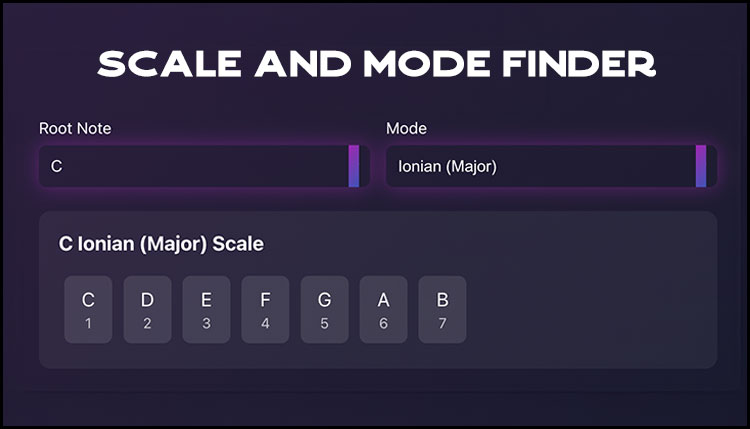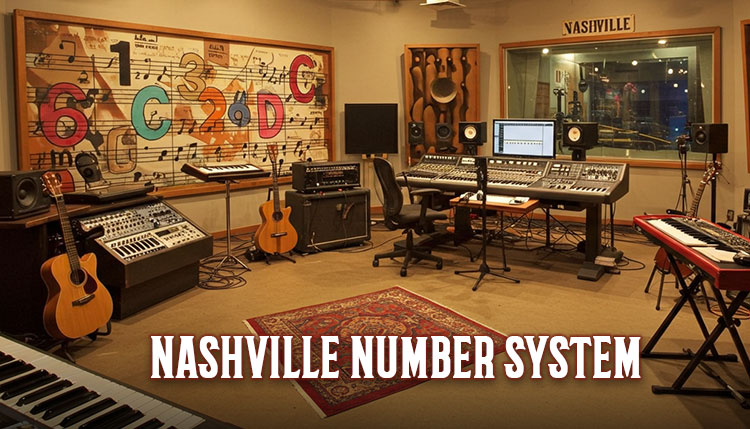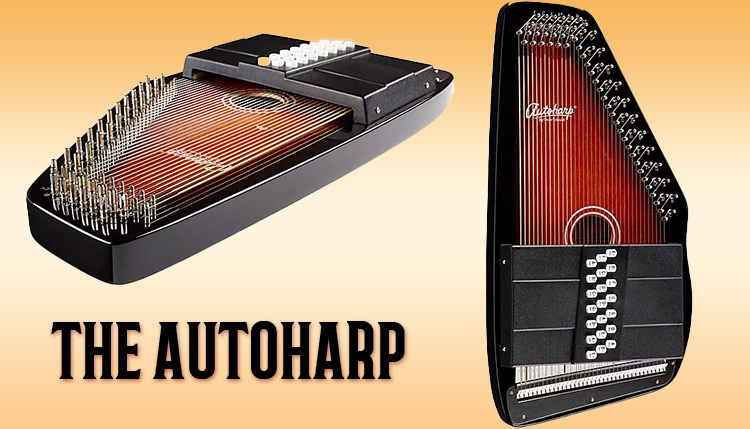Ready to take your vocal recordings to the next level? You’re in the right place!
I’ve seen firsthand how the right vocal recording techniques can transform a good song into a chart-topping hit.
Creating pristine vocal recordings can only aid in the success of your song.
Let’s dive into the world of vocal recording and uncover the secrets that’ll make your tracks shine!
Choose the Right Microphone

Let me tell you, picking the best microphone for vocals can make or break your recordings.
I learned this the hard way when I first started buying my music production equipment.
I thought I could get away with using my old USB mic from college for everything. Boy, was I wrong!
Types of Mics
First things first, you gotta understand the different types of mics out there.
You’ve got your dynamic mics, which are tough as nails and great for live performances.
Then there’s condenser mics, which are super sensitive and perfect for capturing all those subtle nuances in a vocal performance.
And don’t forget about ribbon mics – they’re old school but can give you that warm, vintage sound.
I remember trying to record a rock vocalist with a cheap condenser mic once. It was a disaster!
The mic couldn’t handle the high sound pressure levels, and we ended up with a distorted mess.
That’s when I learned the importance of matching the mic to the vocal style and genre.
Budget Mics
If you’re on a budget, don’t worry. There are plenty of decent options out there that won’t break the bank.
I’ve had great results with the Shure SM58 for dynamic mics and the Audio-Technica AT2020 for condensers.
They’re not top-of-the-line, but they’ll get the job done.
Pro Tip: Proper mic positioning is key. I can’t tell you how many times I’ve seen people stick the mic right up to their mouth and wonder why they’re getting all that popping and distortion.
Try this:
- Start with the mic about 6-8 inches away from your mouth
- Angle it slightly off-axis to reduce plosives
- Experiment with different distances and angles to find the sweet spot
Remember, every voice is different, so what works for one person might not work for another.
Don’t be afraid to play around and find what sounds best for you or your vocalist.
Oh, and one more thing – invest in a good mic stand!
I learned this the hard way when my cheap stand collapsed mid-session, nearly taking out my prized condenser mic.
Talk about a heart attack!
Optimize Your Recording Space

Alright, let’s talk about getting your recording space up to snuff.
When I first started learning how to product music I thought I could just throw up a mic in my bedroom and call it a day.
Spoiler alert: it didn’t sound great.
Acoustics
DIY acoustic treatment is your best friend when you’re working with a home studio setup.
You don’t need to break the bank to get decent results.
I’ve used everything from old blankets to egg cartons to tame those pesky reflections.
One time, I even stuffed a closet full of pillows and blankets to create a makeshift vocal booth. It wasn’t pretty, but it worked!
Managing room reflections and echo is crucial for getting a clean vocal sound.
I learned this the hard way when I tried to record in my tiled bathroom.
Sure, the reverb sounded cool, but it was impossible to control in the mix.
Here are some quick tips:
- Avoid rooms with parallel walls if possible
- Use soft furnishings like curtains and rugs to absorb sound
- Place acoustic panels or DIY absorbers at reflection points
Environment
Creating a comfortable environment for vocalists is super important.
I once had a singer who couldn’t perform because the room was too cold.
Now I always keep a space heater and some cozy blankets on hand.
It’s the little things that can make or break a session.
When it comes to essential equipment for a vocal recording setup, you don’t need to go overboard.
Here’s what I consider the bare minimum:
- A decent mic (obviously)
- A pop filter
- A sturdy mic stand
- Closed-back headphones for monitoring
- An audio interface
I remember trying to record without a pop filter once. Big mistake!
Every ‘p’ and ‘b’ sound was like a mini explosion. Now I never record vocals without one.
Lighting
One last thing – don’t forget about lighting!
I once had a session where the vocalist kept squinting because the room was too bright.
Now I always have some soft, adjustable lighting on hand to create the right mood.
Remember, your recording space doesn’t have to be perfect.
It just needs to be good enough to capture a clean, usable vocal take.
With a little creativity and some DIY spirit, you can turn almost any room into a decent vocal recording space.
Prepare Your Vocalist for Success
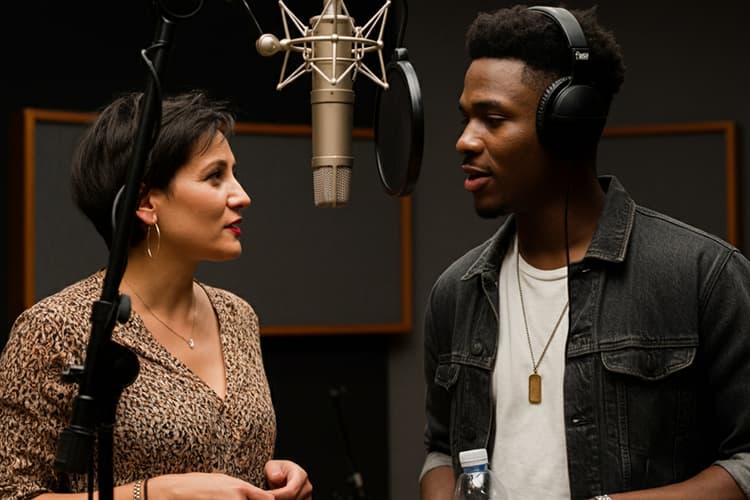
Okay, let’s talk about getting your vocalist ready to nail that perfect take.
Trust me, I’ve learned the hard way that a little preparation goes a long way.
Warm Up
First up, warm-up exercises. I used to think these were just for fancy opera singers, but boy was I wrong!
I once had a session where the vocalist jumped right into belting out high notes without warming up.
By the third take, their voice was shot.
Now I always make sure we do some simple warm-ups before hitting record.
Here are a few of my favorites:
- Lip trills (they look silly but work wonders)
- Gentle humming exercises
- Scales and arpeggios (start slow and gentle)
Hydration
Hydration is key, folks! I keep a stash of room temperature water in my studio at all times.
Cold water can tighten up the vocal cords, which is not what you want.
And don’t even get me started on the time a vocalist insisted on drinking iced coffee before a session.
Let’s just say it didn’t end well.
Atmosphere
Creating a relaxed atmosphere is crucial for getting the best performance.
I once had a singer who was so nervous they could barely get through a take without their voice shaking.
Now I always take some time to chat and joke around before we start recording.
It helps everyone loosen up and get in the zone.
Patience
When it comes to multiple takes and comping, patience is your best friend.
I used to get frustrated when a vocalist couldn’t nail the perfect take in one go.
Now I know that some of the best vocals are pieced together from multiple takes.
Here’s my approach:
- Record a few full takes to get the overall vibe
- Focus on problem areas and record those sections separately
- Don’t be afraid to comp together the best parts of different takes
One time, I had a singer who was struggling with a particularly difficult chorus.
We ended up recording it line by line, and the final result sounded amazing.
Sometimes you gotta get creative to get the job done!
Pro Tip: Keep some throat lozenges on hand. They can be a lifesaver when a vocalist’s throat starts getting scratchy after multiple takes.
Remember, every vocalist is different. Some need lots of encouragement, while others prefer to be left alone to do their thing.
Learn to read the room and adjust your approach accordingly. And most importantly, always be supportive and positive.
A little encouragement can go a long way in getting that perfect vocal take.
Master Your Vocal Recording Techniques
Alright, let’s dive into the nitty-gritty of actually recording those vocals.
I’ve made pretty much every mistake in the book when it comes to this stuff, so learn from my fails, people!
Gain Level
First up, setting appropriate gain levels.
This is super important, and I learned it the hard way when I recorded an entire session only to find out later that everything was distorted. Ugh!
Now I always start with the gain low and gradually increase it until I’m getting a good signal without any clipping.
A good rule of thumb is to aim for peaks around -6 to -12 dB on your meter.
Pop Filters
Using pop filters and windscreens effectively can make a huge difference in your recordings.
I remember the first time I used a pop filter – it was like magic! All those nasty plosives just disappeared.
Here’s a quick tip: place the pop filter about 2-3 inches away from the mic for best results.
Soundcheck
Monitoring and preventing distortion is crucial.
I once had a singer with a super powerful voice, and I kept getting distortion on the loud parts.
Turns out, I needed to back them up a bit from the mic.
Now I always do a quick soundcheck and listen carefully for any hints of distortion before we start recording for real.
Emotion
Capturing emotion and dynamics in vocal performances is where the magic happens.
I used to think that a technically perfect take was always the best, but I’ve learned that sometimes a slightly imperfect take with more emotion can be way more powerful.
Here are some tricks I use:
- Encourage the vocalist to move and gesture naturally while singing
- Try different mic techniques for different parts of the song
- Don’t be afraid to let some natural imperfections shine through
I remember one session where the singer was really struggling to connect emotionally with the song.
We took a break, had a heart-to-heart about what the lyrics meant to them, and when we came back, the performance was fire.
Sometimes you gotta dig deep to get the good stuff.
Oh, and here’s something I wish someone had told me earlier: always record some room tone!
That’s just a few seconds of silence in the room. It can be a lifesaver for editing later.
Phase
Lastly, don’t forget to check your phase if you’re using multiple mics.
I once recorded a duet with two mics and couldn’t figure out why it sounded so thin. Turns out, the mics were out of phase.
A quick flip of the polarity switch and bam – problem solved!
Remember, recording techniques are just tools.
The most important thing is capturing a great performance.
So don’t get so caught up in the technical stuff that you forget to actually listen to the music.
Trust your ears, and if it sounds good, it is good!
Enhance Your Recordings with Signal Processing

Okay, let’s talk about some making those vocal recordings shine with some music production basics.
I’ve got to admit, when I first laid hands on the best free DAW i could get, I went way overboard with effects.
I thought more was always better. Spoiler alert: it’s not!
EQ
Let’s start with EQ techniques for clarity and presence.
I remember the first time I really understood how to use EQ on vocals.
It was like putting on glasses and suddenly seeing everything clearly.
Here are some quick tips:
- Cut around 100-200 Hz to reduce muddiness
- Boost around 3-5 kHz for presence and clarity
- Be gentle! Small adjustments often work better than drastic ones
Compression
Compression settings for consistent vocal levels can be tricky to get right.
I used to just slap on a audio compressor and crank it up, thinking it would make everything sound “professional”. Boy, was I wrong!
Now I take a more subtle approach:
- Start with a low ratio (2:1 or 3:1) and adjust from there
- Set the threshold so you’re getting 3-6 dB of gain reduction on the loudest parts
- Use a longer attack time to let the transients through
De-esser
De-essing is super important for taming those harsh ‘s’ sounds.
I once had a singer with particularly sibilant vocals, and it was driving me crazy. A de-esser saved the day!
Just be careful not to overdo it, or you’ll end up with lispy vocals.
Reverb and Delay
Now, let’s talk about reverb and delay effects for depth and space.
I used to think more reverb was always better.
Then I realized my mixes sounded like they were recorded in a cave. Oops!
Here’s what I’ve learned:
- Use reverb sparingly – a little goes a long way
- Try using delay instead of reverb for a cleaner sound
- Experiment with pre-delay to create separation between the dry and wet signals
One time, I was working on a track and couldn’t figure out why the vocals sounded so distant.
Turns out, I had way too much reverb on them.
I dialed it back, and suddenly the vocals were right up front where they belonged.
Oh, and here’s a cool trick I learned: try using different reverbs on different parts of the vocal.
A shorter reverb on verses and a longer one on choruses can add some nice variation to the sound.
Remember, the goal of signal processing is to enhance the vocal, not to completely change it.
Always start with a good recording, and use effects to complement it, not cover it up.
And don’t forget to take frequent breaks to rest your ears.
Trust me, ear fatigue is real, and it can lead to some questionable mixing decisions!
Post-Production Vocal Recording Techniques
Alright, let’s dive into the wonderful world of post-production.
This is where you can really make your vocals shine… or totally mess them up if you’re not careful. Trust me, I’ve done both!
Pitch Correction
First up, let’s talk about pitch correction and autotune. Now, I know this can be a controversial topic, but hear me out.
I used to be totally against any kind of pitch correction. I thought it was cheating.
But then I had a session with a singer who was nailing the emotion of the song but just slightly off pitch in a few spots.
A little pitch correction saved the take and the performance.
Here’s my approach now:
- Use pitch correction subtly to enhance a good performance, not to fix a bad one
- Try manual pitch correction first before reaching for automatic tools
- Be careful not to overdo it – a little humanity in the pitch can add character
Vocal Doubles
Vocal doubling and harmonizing techniques can add so much depth to your tracks.
I remember the first time I tried double tracking vocals – it was like magic!
Here are some tips:
- Have the singer perform the double slightly differently for a more natural sound
- Use panning to create width with doubled vocals
- Experiment with harmonies – sometimes unexpected intervals can sound amazing
Vocal Effects
Creating vocal effects and textures is where you can really get creative.
I once worked on a track where we ran the vocals through a guitar amp simulator for a gritty effect. It sounded so cool!
Don’t be afraid to experiment with:
- Distortion or saturation for edge and attitude
- Chorus or flanger for a dreamy, psychedelic vibe
- Vocoder or talkbox for robotic effects
Mixing Vocals
Mixing vocals to sit perfectly in the track is probably the biggest challenge. I used to struggle with this so much until i learned how to mix music properly.
Either the vocals were way too loud and in-your-face, or they’d get totally lost in the mix.
Here’s what I’ve learned:
• Use automation to adjust the vocal level throughout the song
• Carve out space for the vocals with EQ on other instruments
• Don’t forget about panning – moving other elements to the sides can help the vocals stand out in the center
One time, I spent hours trying to get the vocals to sit right in a mix.
I was EQing, compressing, adding effects… nothing was working.
Then I realized I had forgotten the most basic step – adjusting the fader!
A simple volume adjustment was all it needed.
Pro Tip: Always check your mix on different systems. What sounds great on your studio monitors might not translate to car speakers or earbuds.
Remember, post-production is about enhancing what’s already there, not completely changing it.
Start with a great performance and a solid recording, and use these techniques to take it to the next level.
And most importantly, trust your ears. If it sounds good, it is good!
Conclusion on Vocal Recording Techniques
There you have it – a treasure trove of vocal recording techniques to elevate your music production game!
Remember, great vocal recordings are the heart and soul of most hit songs.
By implementing these pro tips, you’ll be well on your way to creating studio-quality vocals that captivate listeners.
Don’t be afraid to experiment and find your unique sound.
Now, go forth and record those chart-topping vocals – your audience is waiting!

